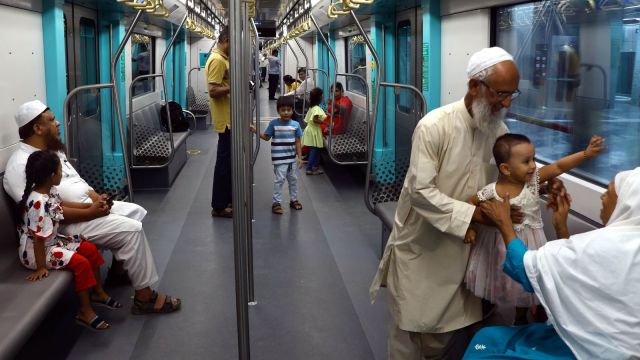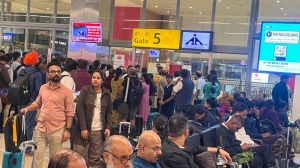15,713 commuters experience underground travel on Day 1 as Mumbai Metro Line 3 begins operations
The station staff expect footfall to increase once the Metro becomes part of regular commute for more people.
 Throughout the day, Metro Line 3 will run 96 roundtrip services using seven operational trains. (Express photo by Amit Chakravarty)
Throughout the day, Metro Line 3 will run 96 roundtrip services using seven operational trains. (Express photo by Amit Chakravarty)The much-awaited public operations of Mumbai Metro Line 3 began on Monday, offering the citizens a new underground experience between Bandra-Kurla Complex (BKC) and Aarey JVLR. Around 15713 ridership was recorded on day one, heavier in the evening. However, the morning saw only a few commuters, most of whom came to experience the underground journey or to see if the new route fits into their daily commute.
Later in the day also, it missed the usual rush hour traffic, resulting in relatively empty stations and trains. However, those who travelled were impressed by the advanced infrastructure and ease of journey.
The station staff expect footfall to increase once the Metro becomes part of regular commute for more people. “Since it was launched at an off-peak time, we didn’t see the rush we’re used to on other Metro lines. But the eight-coach trains are designed to handle large crowds, and we’re prepared for more passengers,” said a station employee.
Also called Aqua Line, one of the notable features of Metro 3 is its pricing, with fares ranging from Rs 10 to Rs 50, depending on the distance. The line includes 10 stations between Aarey JVLR and BKC, with notable stops at Terminal 1 (T1) and Terminal 2 (T2) of the Mumbai airport. Additionally, the Aqua Line connects with the main line at Marol Naka, simplifying inter-line travel for passengers.
Santacruz resident Ravindra Gandhi was one of the first to take a ride on the new Metro with his five-year-old son. “I wanted to see what this new underground Metro was all about and I thought it would be a fun experience for my kid. The experience is different from other Metro lines. We had some trouble finding our way, but I think it will get easier with time,” he said.
Throughout the day, Metro Line 3 will run 96 roundtrip services using seven operational trains. Two additional trains are kept as back-up in case of any technical issues or maintenance. Passengers can buy tickets through mobile apps, ticket counters, vending machines and the MMRCL website.
Impressed by the infrastructure and convenience, Rajendra Rao, a commuter from Andheri, said, “The stations are well-designed and the ride is very smooth. The fare is also quite affordable for the convenience it provides. But some clear announcements or pop-ups for navigating easily through stations would help.”
Several commuters noted poor mobile connectivity at stations and inside the train. To address this, the MMRCL will shortly have seamless 4G and 5G mobile network connectivity from different service providers on all its stations and inside the train, said an official.
Some commuters raised concerns about external factors affecting their overall experience. J Ashwin, a commuter from Jogeshwari, pointed out the difficulties in reaching the Metro station itself. “The Metro is great, but getting here is a challenge. Connectivity to the stations is still an issue. It would have been better if the government worked on improving access outside the stations as well,” he said.
Some commuters also pointed out how the new Metro line has become a new source of earnings for auto-rickshaws catering to the feeder routes. “Auto-rickshaws are making money by transporting commuters to the stations, but the government needs to monitor the dominance of these ‘auto mafias’ who might exploit passengers,” one commuter mentioned. There are concerns that this might lead to inflated fares and difficulties for regular commuters if strict regulation isn’t enforced.
With its modern design and connectivity to key locations such as the airport, Mumbai Metro 3 or the Aqua Line is reportedly expected to become a popular choice for commuters, especially once the connectivity issues are addressed.







